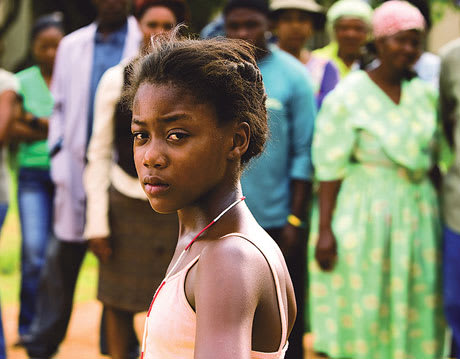Life, Above All is a no-frills, social-realist film from South Africa that examines the effect of the AIDS crisis and urbanization on one small village outside of Johannesburg. It begins with the death of a newborn child, examining one family's struggles with grief, trauma and the spectre of disease.
Reminiscent of the films of the Dardenne brothers, consider Life, Above All to be analogous of a South African version of True Grit. Both films feature tenacious young girls forced into independence who have had their childhood interrupted by great tragedy, and both see the world with clear, unwearied eyes out of necessity.
Khomotso Manyaka is Chanda, a 12-year-old girl thrust into caring for her ailing mother and attempting to keep her fracturing family together. Manyaka (here in her first role) is remarkable as Chanda; she's the heart and soul of the film, and the reason it works. Her duty is to be the moral centre, selflessly trying to hold the pieces together. Manyaka is in every scene, and everything that happens in the film we see through her eyes. Director Oliver Schmitz has done a wonderful job with Manyaka (and the other members of his young cast), coaxing honest, subtle performances free of childlike shtick.
While the word "AIDS" doesn't actually come into play until late in the film (it's merely hinted at), it is of primary concern. The film feels a little sanitized, shying away from depicting genuine poverty, but it also wisely doesn't traffic in miserabilism or guilt-porn. The mildly pretentious title aside, Life, Above All is about seeking redemption through personal struggle and integrity.
The film's greatest strength is how it depicts the life and culture of its social milieu, examining not just public health, but using Chanda to explore elements of family, religion, education and modernization in contemporary South Africa. It is an eye-opener.
(Mongrel Media)Reminiscent of the films of the Dardenne brothers, consider Life, Above All to be analogous of a South African version of True Grit. Both films feature tenacious young girls forced into independence who have had their childhood interrupted by great tragedy, and both see the world with clear, unwearied eyes out of necessity.
Khomotso Manyaka is Chanda, a 12-year-old girl thrust into caring for her ailing mother and attempting to keep her fracturing family together. Manyaka (here in her first role) is remarkable as Chanda; she's the heart and soul of the film, and the reason it works. Her duty is to be the moral centre, selflessly trying to hold the pieces together. Manyaka is in every scene, and everything that happens in the film we see through her eyes. Director Oliver Schmitz has done a wonderful job with Manyaka (and the other members of his young cast), coaxing honest, subtle performances free of childlike shtick.
While the word "AIDS" doesn't actually come into play until late in the film (it's merely hinted at), it is of primary concern. The film feels a little sanitized, shying away from depicting genuine poverty, but it also wisely doesn't traffic in miserabilism or guilt-porn. The mildly pretentious title aside, Life, Above All is about seeking redemption through personal struggle and integrity.
The film's greatest strength is how it depicts the life and culture of its social milieu, examining not just public health, but using Chanda to explore elements of family, religion, education and modernization in contemporary South Africa. It is an eye-opener.




